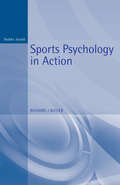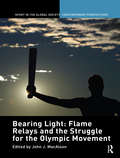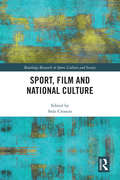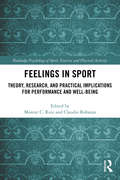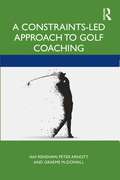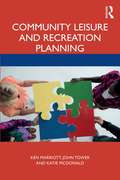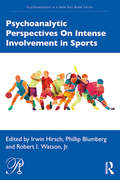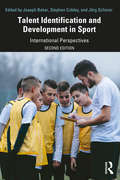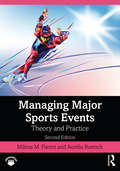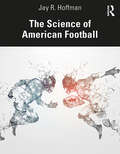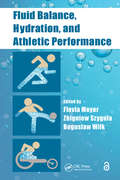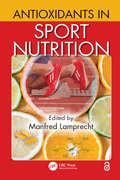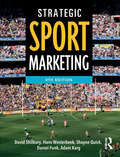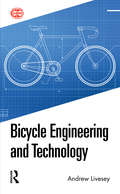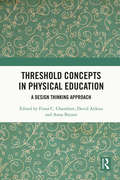- Table View
- List View
Sports Psychology in Action
by Richard ButlerPsychological preparation is now recognised as being of key importance in improving sports performance. This book describes performance profiling methods used by coaches and psychologists and exercises and assessments are presented in an accessiblestyle. Although based on practical experience, the text is firmly rooted in research. It is therefore an innovative and authoritative book that can be used at both professional and amateur level.Sports performers continually endeavour to excel at what they do and to break records. Their search for new and innovative techniques which might enable them to achieve these aims is unceasing. This book offers accessible and practical guidance on anincreasingly important and proven approach - the use of mental processes to enhance physical performance. It is now recognised that psychology has a key role in sports, not only in improving performance, but also in helping sportsmen and women attain asense of mastery of their discipline. The book explores the important characteristics in top sporting performance and illustrates techniques and exercises designed to assist athletes reach their potential. It should be an essential part of any serioussports performance preparation. * Very practical, easy to use, clearly presented * Based on a model of psychology which emphasises the importance of understanding the performer's view * All techniques rigorously tested at an elite level 'This isa book for everyone interesteed in individual sports performance. I wholeheartedly recommend this book.' - Brit. Assoc. of Sports Sciences News, April 1996
Bearing Light: Flame Relays and the Struggle for the Olympic Movement (Sport In The Global Society - Contemporary Perspectives Ser.)
by John J. MacAloonThe Flame Relay and the Olympic Movement is the first book-length scholarly study in English of the contemporary Olympic flame relay. Reporting for the first time on years of intensive ethnographic research and organizational intervention, MacAloon literally follows the Olympic flame through twenty years of intercultural encounter, conflict, and negotiation. Focusing on the frequently harmonious, sometimes perilous encounters among Greek flame relay officials, cultural agents, and discourses, foreign Olympic Games organizing committees, and such transnational actors as the IOC and its corporate sponsors since 1984, a context is created for understanding the significance for the Olympic movement and for globalization studies of the 2004 Athens flame relay, the first to travel the entire world. Through intensive interviews and co-participations with leading Greek and American actors and the contributions of young Greek researchers who worked backstage on the relay, Bearing Light demonstrates how culturally parochial the managerial regime of "world’s best practices" often turns out to be and yet how inescapable it has become for those who wish to communicate across cultural and political boundaries. This dilemma, the contributors argue, constitutes the practical form in which the struggle to preserve a sense of "Olympism" and "the Olympic Movement" against the demands and prerogatives of today’s Olympic sports industry is being chiefly fought out.This book was previously published as a special issue of Sport in Society
Sport, Film and National Culture (Routledge Research in Sport, Culture and Society)
by Seán CrossonSport and film have historically been key components of national cultures and societies. This is the first collection dedicated to examining the intersection of these popular cultural forces within specific national contexts. Covering films of all types, from Hollywood blockbusters to regional documentaries and newsreels, the book considers how filmic depictions of sport have configured and informed distinctive national cultures, societies and identities. Featuring case studies from 11 national contexts across 6 continents – including North and South America, Europe, Africa, Asia and Oceania – it reveals the common and contrasting approaches that have emerged within sport cinema in differing national contexts. This is fascinating and important reading for all students and researchers working in film, media, cultural studies or sport, and for broader enthusiasts of both sport and film.
Sport, Film and National Culture (Routledge Research in Sport, Culture and Society)
by Seán CrossonSport and film have historically been key components of national cultures and societies. This is the first collection dedicated to examining the intersection of these popular cultural forces within specific national contexts. Covering films of all types, from Hollywood blockbusters to regional documentaries and newsreels, the book considers how filmic depictions of sport have configured and informed distinctive national cultures, societies and identities. Featuring case studies from 11 national contexts across 6 continents – including North and South America, Europe, Africa, Asia and Oceania – it reveals the common and contrasting approaches that have emerged within sport cinema in differing national contexts. This is fascinating and important reading for all students and researchers working in film, media, cultural studies or sport, and for broader enthusiasts of both sport and film.
Feelings in Sport: Theory, Research, and Practical Implications for Performance and Well-being (Routledge Psychology of Sport, Exercise and Physical Activity)
by Montse Ruiz Claudio RobazzaFeeling states, including emotional experiences, are pervasive to human functioning. Feeling states deeply influence the individual’s effort, attention, decision making, memory, behavioural responses, and interpersonal interactions. The sporting environment offers an ideal setting for the development of research questions and applied interventions to improve the well-being and well-functioning of the people involved. This ground-breaking book is the first to offer cutting-edge knowledge about contemporary theoretical, methodological, and applied issues with the contributions of leading researchers and practitioners in the field. Feeling states in sports are comprehensively covered by adopting an international and multi-disciplinary perspective. Part I covers most relevant conceptual frameworks, including emotion-centred and action-centred approaches, challenge and threat evaluations, an evolutionary approach to emotions, and the role of passion in the experience of emotion. Part II focuses on interpersonal aspects related to emotions and regulation, encompassing social and interpersonal emotion influence and regulation, social identity and group-based emotions, and performance experiences in teams. Part III presents applied indications surrounding emotional intelligence training, and emotional regulation strategies including imagery, self-talk, the use of music, mindfulness, motor skills execution under pressure, self-regulation in endurance sports, and the use of technology. Finally, Part IV examines issues related to athlete well-being, including the role of emotions in sport injury, emotional eating, and mental recovery. Feelings in Sport: Theory, Research, and Practical Implications for Performance and Well-being is an essential source for sport psychology practitioners, researchers, sports coaches, undergraduate and postgraduate students.
Feelings in Sport: Theory, Research, and Practical Implications for Performance and Well-being (Routledge Psychology of Sport, Exercise and Physical Activity)
by Montse Ruiz Claudio RobazzaFeeling states, including emotional experiences, are pervasive to human functioning. Feeling states deeply influence the individual’s effort, attention, decision making, memory, behavioural responses, and interpersonal interactions. The sporting environment offers an ideal setting for the development of research questions and applied interventions to improve the well-being and well-functioning of the people involved. This ground-breaking book is the first to offer cutting-edge knowledge about contemporary theoretical, methodological, and applied issues with the contributions of leading researchers and practitioners in the field. Feeling states in sports are comprehensively covered by adopting an international and multi-disciplinary perspective. Part I covers most relevant conceptual frameworks, including emotion-centred and action-centred approaches, challenge and threat evaluations, an evolutionary approach to emotions, and the role of passion in the experience of emotion. Part II focuses on interpersonal aspects related to emotions and regulation, encompassing social and interpersonal emotion influence and regulation, social identity and group-based emotions, and performance experiences in teams. Part III presents applied indications surrounding emotional intelligence training, and emotional regulation strategies including imagery, self-talk, the use of music, mindfulness, motor skills execution under pressure, self-regulation in endurance sports, and the use of technology. Finally, Part IV examines issues related to athlete well-being, including the role of emotions in sport injury, emotional eating, and mental recovery. Feelings in Sport: Theory, Research, and Practical Implications for Performance and Well-being is an essential source for sport psychology practitioners, researchers, sports coaches, undergraduate and postgraduate students.
A Constraints-Led Approach to Golf Coaching (Routledge Studies in Constraints-Based Methodologies in Sport)
by Ian Renshaw Peter Arnott Graeme McDowallWhile the popularity of golf is coming under increased pressure, it continues to hook millions of players. However, the complexity of the game and the extremely high level of precision required to hit the ball consistently well means that it is a game that is difficult to even become ‘good’ at, let alone master. Consequently, irrespective of whether the player is a weekend golfer, a club member, or a tour professional, the search for the key to playing good golf feeds an insatiable desire for ideas and tips to improve golf performance and bring one’s handicap down. However, traditional coaching, with its primary focus on developing the perfect swing is not leading to a reduction in handicaps and the time is ripe for a new approach. This book aims to fill this void and is a landmark text for golf coaches and players about applying a constraints-led approach (CLA) to golf coaching. In this book, two golf coaches, Pete Arnott and Graeme McDowall talk to Ian Renshaw to demonstrate how their practice is driven and inspired by their alignment to a CLA. A Constraints-Led Approach to Golf Coaching includes case studies and examples of how constraints are manipulated to induce adaption in the technical, tactical (or put in golf terms, course management), physiological, and psychological development mechanisms needed to improve at golf. Examples cover coaching from their work with beginners, high handicappers, aspirant tour players, and elite players looking to make the ‘tour’.
A Constraints-Led Approach to Golf Coaching (Routledge Studies in Constraints-Based Methodologies in Sport)
by Ian Renshaw Peter Arnott Graeme McDowallWhile the popularity of golf is coming under increased pressure, it continues to hook millions of players. However, the complexity of the game and the extremely high level of precision required to hit the ball consistently well means that it is a game that is difficult to even become ‘good’ at, let alone master. Consequently, irrespective of whether the player is a weekend golfer, a club member, or a tour professional, the search for the key to playing good golf feeds an insatiable desire for ideas and tips to improve golf performance and bring one’s handicap down. However, traditional coaching, with its primary focus on developing the perfect swing is not leading to a reduction in handicaps and the time is ripe for a new approach. This book aims to fill this void and is a landmark text for golf coaches and players about applying a constraints-led approach (CLA) to golf coaching. In this book, two golf coaches, Pete Arnott and Graeme McDowall talk to Ian Renshaw to demonstrate how their practice is driven and inspired by their alignment to a CLA. A Constraints-Led Approach to Golf Coaching includes case studies and examples of how constraints are manipulated to induce adaption in the technical, tactical (or put in golf terms, course management), physiological, and psychological development mechanisms needed to improve at golf. Examples cover coaching from their work with beginners, high handicappers, aspirant tour players, and elite players looking to make the ‘tour’.
Community Leisure and Recreation Planning
by Ken Marriott John Tower Katie McDonaldCommunity Leisure and Recreation Planning offers an up-to-date, evidence-based approach to planning community leisure and recreation facilities, programs and services. It introduces readers to key theory and best practice in the planning of effective leisure and recreation projects. The book defines planning, leisure, recreation and other key concepts and explains why a thorough planning process is essential to achieving effective outcomes. It presents a comprehensive, integrative four phase model for undertaking leisure and recreation planning, including: pre-planning, planning research, preparing a plan, and implementing, monitoring and evaluating the outputs and outcomes of a plan. It provides a conceptual rationale for each component of the planning process, a detailed explanation of the tools and techniques that can be used, and extensive examples and international case study materials to demonstrate their use. The principles and techniques explained in the book are applicable at a range of community levels from small individual sites to regions, states and even countries. This is an essential course text for all leisure and recreation courses, and invaluable reading for academics, practitioners, stakeholders and students working in leisure and recreation planning, events, culture and sport.
Psychoanalytic Perspectives On Intense Involvement in Sports (Psychoanalysis in a New Key Book Series)
by Irwin Hirsch Robert Watson Phillip BlumbergThis book is a unique volume that brings a variety of psychoanalytic perspectives to the study of sport. It highlights the importance of sports for different individuals and how the function and use of sports can be brought into the consulting room. Passionate interest in actively engaging in sports is a universal phenomenon. It is striking that this aspect of human life, prior to this volume, has received little attention in the literature of psychoanalysis. This edited volume is comprised largely of psychoanalysts who are themselves avidly involved with sports. It is suggested that intense involvement in sports prioritizes commitment and active engagement over passivity and that such involvement provides an emotionally tinged distraction from the various misfortunes of life. Indeed, the ups and downs in mood related to athletic victory or defeat often supplant, temporarily, matters in life that may be more personally urgent. Engaging in sports or rooting for teams provides a feeling of community and a sense of identification with like-minded others, even among those who are part of other communities and have sufficient communal identifications. This book offers a better psychoanalytic understanding of sports to help us discover more about ourselves, our patients and our culture, and will be of great interest to psychotherapists and psychoanalysts, or anyone with an interest in sport and its link to psychoanalysis and mental health.
Community Leisure and Recreation Planning
by Ken Marriott John Tower Katie McDonaldCommunity Leisure and Recreation Planning offers an up-to-date, evidence-based approach to planning community leisure and recreation facilities, programs and services. It introduces readers to key theory and best practice in the planning of effective leisure and recreation projects. The book defines planning, leisure, recreation and other key concepts and explains why a thorough planning process is essential to achieving effective outcomes. It presents a comprehensive, integrative four phase model for undertaking leisure and recreation planning, including: pre-planning, planning research, preparing a plan, and implementing, monitoring and evaluating the outputs and outcomes of a plan. It provides a conceptual rationale for each component of the planning process, a detailed explanation of the tools and techniques that can be used, and extensive examples and international case study materials to demonstrate their use. The principles and techniques explained in the book are applicable at a range of community levels from small individual sites to regions, states and even countries. This is an essential course text for all leisure and recreation courses, and invaluable reading for academics, practitioners, stakeholders and students working in leisure and recreation planning, events, culture and sport.
Psychoanalytic Perspectives On Intense Involvement in Sports (Psychoanalysis in a New Key Book Series)
by Irwin HirschThis book is a unique volume that brings a variety of psychoanalytic perspectives to the study of sport. It highlights the importance of sports for different individuals and how the function and use of sports can be brought into the consulting room. Passionate interest in actively engaging in sports is a universal phenomenon. It is striking that this aspect of human life, prior to this volume, has received little attention in the literature of psychoanalysis. This edited volume is comprised largely of psychoanalysts who are themselves avidly involved with sports. It is suggested that intense involvement in sports prioritizes commitment and active engagement over passivity and that such involvement provides an emotionally tinged distraction from the various misfortunes of life. Indeed, the ups and downs in mood related to athletic victory or defeat often supplant, temporarily, matters in life that may be more personally urgent. Engaging in sports or rooting for teams provides a feeling of community and a sense of identification with like-minded others, even among those who are part of other communities and have sufficient communal identifications. This book offers a better psychoanalytic understanding of sports to help us discover more about ourselves, our patients and our culture, and will be of great interest to psychotherapists and psychoanalysts, or anyone with an interest in sport and its link to psychoanalysis and mental health.
Talent Identification and Development in Sport: International Perspectives
by Joseph Baker Stephen Cobley Jörg SchorerIdentifying and developing talented athletes to their fullest potential is a central concern of sport scientists, sports coaches, and sports policy makers. The second edition of this popular text offers a state of the science synthesis of current knowledge in talent identification and development in sport, from the biological basis of talent to the systems and processes within sport through which that talent is nurtured. Written by a team of leading international experts, the book explores key factors and issues in contemporary sport, including: nature and nurture in the development of sporting talent designing optimal developmental environments long-term modelling of athlete development understanding the complexity of talent selection in-depth case studies of successful talent development systems. With an emphasis on practical implications for all those working in sport, the book offers an authoritative evaluation of the strengths and weaknesses of contemporary systems for identifying and developing talent in sport. This is important reading for any student, researcher, or practitioner with an interest in skill acquisition, youth sport, elite sport, sports coaching, or sports development.
Talent Identification and Development in Sport: International Perspectives
by Joseph Baker, Stephen Cobley, and Jörg SchorerIdentifying and developing talented athletes to their fullest potential is a central concern of sport scientists, sports coaches, and sports policy makers. The second edition of this popular text offers a state of the science synthesis of current knowledge in talent identification and development in sport, from the biological basis of talent to the systems and processes within sport through which that talent is nurtured. Written by a team of leading international experts, the book explores key factors and issues in contemporary sport, including: nature and nurture in the development of sporting talent designing optimal developmental environments long-term modelling of athlete development understanding the complexity of talent selection in-depth case studies of successful talent development systems. With an emphasis on practical implications for all those working in sport, the book offers an authoritative evaluation of the strengths and weaknesses of contemporary systems for identifying and developing talent in sport. This is important reading for any student, researcher, or practitioner with an interest in skill acquisition, youth sport, elite sport, sports coaching, or sports development.
Managing Major Sports Events: Theory and Practice
by Milena M. Parent Aurélia RuetschManaging Major Sports Events: Theory and Practice is a complete introduction to the principles and practical skills that underpin the running and hosting of major sports events, from initial bid to post-event legacy and sustainability. Now in a fully-revised and updated new edition, the book draws on the latest research from across multiple disciplines; explores real-world situations, and emphasises practical problem-solving skills. It covers every key area in the event management process, including: • Bidding, leadership, and planning • Marketing and human resource management • Venues and ceremonies • Communications and technology (including social media) • Functional area considerations (including sport, protocol, and event services) • Security and risk management • Games-time considerations • Event wrap-up and evaluation • Legacy and sustainability This revised edition includes expanded coverage of cutting-edge topics such as digital media, culture, human resources, the volunteer workforce, readiness, security, and managing Games-time. Each chapter combines theory, practical decision-making exercises and case studies of major sports events from around the world, helping students and practitioners alike to understand and prepare for the reality of executing major events on an international scale. Also new to this edition is an &‘Outlook, Trends and Innovations&’ section in each chapter, plus &‘tips&’ by leading events professionals. Managing Major Sports Events: Theory and Practice is an essential textbook for any course on sports event management or international sports management, and an invaluable resource for all sport management researchers, practitioners and policy-makers. Online resources include PowerPoint slides, multiple choice questions, essay questions and decision-making exercises.
Managing Major Sports Events: Theory and Practice
by Milena M. Parent Aurélia RuetschManaging Major Sports Events: Theory and Practice is a complete introduction to the principles and practical skills that underpin the running and hosting of major sports events, from initial bid to post-event legacy and sustainability. Now in a fully-revised and updated new edition, the book draws on the latest research from across multiple disciplines; explores real-world situations, and emphasises practical problem-solving skills. It covers every key area in the event management process, including: • Bidding, leadership, and planning • Marketing and human resource management • Venues and ceremonies • Communications and technology (including social media) • Functional area considerations (including sport, protocol, and event services) • Security and risk management • Games-time considerations • Event wrap-up and evaluation • Legacy and sustainability This revised edition includes expanded coverage of cutting-edge topics such as digital media, culture, human resources, the volunteer workforce, readiness, security, and managing Games-time. Each chapter combines theory, practical decision-making exercises and case studies of major sports events from around the world, helping students and practitioners alike to understand and prepare for the reality of executing major events on an international scale. Also new to this edition is an &‘Outlook, Trends and Innovations&’ section in each chapter, plus &‘tips&’ by leading events professionals. Managing Major Sports Events: Theory and Practice is an essential textbook for any course on sports event management or international sports management, and an invaluable resource for all sport management researchers, practitioners and policy-makers. Online resources include PowerPoint slides, multiple choice questions, essay questions and decision-making exercises.
The Science of American Football
by Jay R. HoffmanThe game of American football may be the greatest team sport that exists. It epitomizes the need of a "team" first approach to achieve the desired success. Success is often measured as the hoisting of a championship trophy, which involved a journey that required discipline, perseverance, sacrifice, and hard work. These traits are the backbone of success in football, but more importantly they are the backbone or blueprint for success in life. The Science of American Football provides an in-depth discussion on the physiology of the game of American football, including the physiological strain associated with playing in various environmental extremes. Acclimatization, preparation, and medical issues associated with each of these environmental extremes are discussed as well as medical issues occurring during the athlete’s playing career (common sites of injury) and potential risks arising post-career (e.g. neurological dysfunction, arthritic joints, obesity). The book goes on to consider aspects of player selection and preparation, including discussion of evidence-based physical conditioning programs, appropriate nutrition, and specific dietary supplementation for the American football player. The Science of American Football is the first book to focus on the physiology, science, and medical issues associated with the game of American football and will be key reading for students of coaching and exercise science as well as those with a keen interest in understanding the science of American football, such as coaches and players.
The Science of American Football
by Jay R. HoffmanThe game of American football may be the greatest team sport that exists. It epitomizes the need of a "team" first approach to achieve the desired success. Success is often measured as the hoisting of a championship trophy, which involved a journey that required discipline, perseverance, sacrifice, and hard work. These traits are the backbone of success in football, but more importantly they are the backbone or blueprint for success in life. The Science of American Football provides an in-depth discussion on the physiology of the game of American football, including the physiological strain associated with playing in various environmental extremes. Acclimatization, preparation, and medical issues associated with each of these environmental extremes are discussed as well as medical issues occurring during the athlete’s playing career (common sites of injury) and potential risks arising post-career (e.g. neurological dysfunction, arthritic joints, obesity). The book goes on to consider aspects of player selection and preparation, including discussion of evidence-based physical conditioning programs, appropriate nutrition, and specific dietary supplementation for the American football player. The Science of American Football is the first book to focus on the physiology, science, and medical issues associated with the game of American football and will be key reading for students of coaching and exercise science as well as those with a keen interest in understanding the science of American football, such as coaches and players.
Fluid Balance, Hydration, and Athletic Performance
by Flavia MeyerAthletes and nonathletes frequently consume too little water or fluids, affecting exercise performance as well as overall health. This book comprehensively reviews the aspects relating to body fluid balance, rehydration, and physical exercise. It provides background on body water balance and turnover, topics related to electrolyte balance, and sweating as the basis for thermoregulatory and fluid homeostasis during exercise. In addition, chapters cover body water balance evaluation and regulation; cardiovascular and metabolic responses to fluid imbalance; effects of dehydration on aerobic power, muscle strength, and cognitive function; fluid intake timing; and optimal beverage selection.
Antioxidants in Sport Nutrition
by Manfred LamprechtAntioxidant use in sports is controversial due to existing evidence that it both supports and hurts athletic performance. This book presents information on antioxidants, specifically for athletes, and their roles in sports nutrition. It stresses how antioxidants affect exercise performance, health, and immunity. Chapters cover oxidative stress; basic nutrition for athletes; major dietary antioxidants; sports supplements; performance/adaptation to exercise; antioxidants role in health and immunity; reviews on vitamins C, E, beta-carotene, and minerals in sports nutrition; and roles polyphenols play in high-performance sport.
Strategic Sport Marketing
by David Shilbury Shayne Quick Daniel Funk Hans Westerbeek Adam KargSport now has to compete for the consumer dollar with a vast array of leisure activities online as well as offline. Successful sport marketing is the result of carefully structured planning, creativity and perseverance.Integrating the unique characteristics of sport with traditional marketing theory, Strategic Sport Marketing presents a framework of strategic decision-making. The authors outline the diverse markets for sport: participants, sponsors, spectators and fans. International case studies and 'sportviews' selected from a wide range of sports and media illustrate the unique features of sport marketing.Strategic Sport Marketing is a practical tool and theoretical guide to sport marketing internationally. The fourth edition of this widely used text is fully revised and updated. It includes new material on sports promotion, customer service and social media, as well as new case studies.'A sport marketing text at the undergraduate level needs to engage both student and teacher. . . I believe Strategic Sport Marketing does this rather well.' - Sport Management Review'. . . a comprehensive illustration of the integration of sport marketing theory with sport marketing practice.' - Journal of Sport Management
Strategic Sport Marketing
by David Shilbury Shayne Quick Daniel Funk Hans Westerbeek Adam KargSport now has to compete for the consumer dollar with a vast array of leisure activities online as well as offline. Successful sport marketing is the result of carefully structured planning, creativity and perseverance.Integrating the unique characteristics of sport with traditional marketing theory, Strategic Sport Marketing presents a framework of strategic decision-making. The authors outline the diverse markets for sport: participants, sponsors, spectators and fans. International case studies and 'sportviews' selected from a wide range of sports and media illustrate the unique features of sport marketing.Strategic Sport Marketing is a practical tool and theoretical guide to sport marketing internationally. The fourth edition of this widely used text is fully revised and updated. It includes new material on sports promotion, customer service and social media, as well as new case studies.'A sport marketing text at the undergraduate level needs to engage both student and teacher. . . I believe Strategic Sport Marketing does this rather well.' - Sport Management Review'. . . a comprehensive illustration of the integration of sport marketing theory with sport marketing practice.' - Journal of Sport Management
Bicycle Engineering and Technology
by Andrew LiveseyBicycle Engineering and Technology is a primer and technical introduction for anyone interested in bicycles, bicycling and the bicycle industry. With insight into how bicycles are made and operated, the book covers the engineering materials used for their manufacture and the technicalities of riding. It also discusses ways in which the enthusiast may wish to get involved in the business of working with these fantastic machines, which are now being aided with electrical power. The bicycle is a significant factor in transportation around the world and is playing an increasingly crucial role in transport policy as we collectively become more environmentally conscious. To celebrate the importance of the bicycle on the world stage, a brief history is included along with a detailed timeline showing the development of the bicycle with major world events. Previous knowledge of engineering or technology is not required to enjoy this text, as all technical terms are explained and a full glossary and lists of abbreviations are included. Whether you are a bicycling enthusiast, racer, student or bicycle professional, you will surely want to read it and keep it on your shelf as a handy reference.
Bicycle Engineering and Technology
by Andrew LiveseyBicycle Engineering and Technology is a primer and technical introduction for anyone interested in bicycles, bicycling and the bicycle industry. With insight into how bicycles are made and operated, the book covers the engineering materials used for their manufacture and the technicalities of riding. It also discusses ways in which the enthusiast may wish to get involved in the business of working with these fantastic machines, which are now being aided with electrical power. The bicycle is a significant factor in transportation around the world and is playing an increasingly crucial role in transport policy as we collectively become more environmentally conscious. To celebrate the importance of the bicycle on the world stage, a brief history is included along with a detailed timeline showing the development of the bicycle with major world events. Previous knowledge of engineering or technology is not required to enjoy this text, as all technical terms are explained and a full glossary and lists of abbreviations are included. Whether you are a bicycling enthusiast, racer, student or bicycle professional, you will surely want to read it and keep it on your shelf as a handy reference.
Threshold Concepts in Physical Education: A Design Thinking Approach
by Fiona C. Chambers David Aldous Anna BryantThis innovative and user-friendly book uses a design thinking approach to examine transformative learning and liminality in physical education. Covering theory and practice, it introduces the important idea of ‘threshold concepts’ for physical education, helping physical educators to introduce those concepts into curriculum, pedagogy and assessment. The book invites us to reflect on what is learned in, through and about physical education - to identify its core threshold concepts. Once identified, the book explains how the learning of threshold concepts can be planned using principles of pedagogical translation for all four learning domains (cognitive, psychomotor, affective and social). The book is arranged into three key sections which walk the reader through the underpinning concepts, use movement case studies to explore and generate threshold concepts in physical education using design thinking approach and, finally, provide a guiding Praxis Matrix for PE Threshold Concepts that can be used for physical educators across a range of school and physical activity learning contexts. Outlining fundamental theory and useful, practical teaching and coaching advice, this book is invaluable reading for all PE teacher educators, coach educators, and any advanced student, coach or teacher looking to enrich their knowledge and professional practice.
